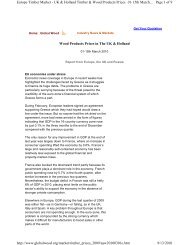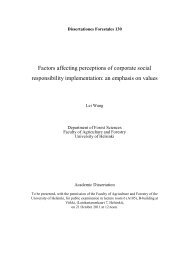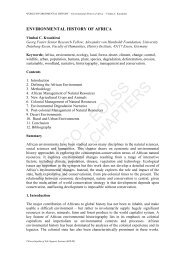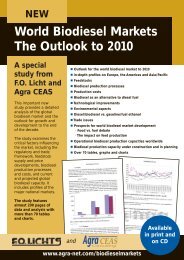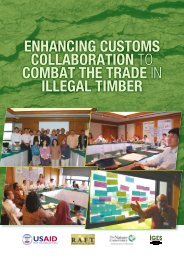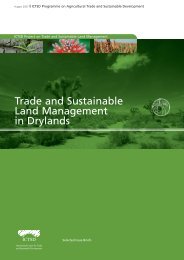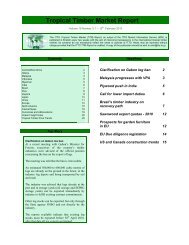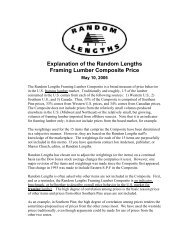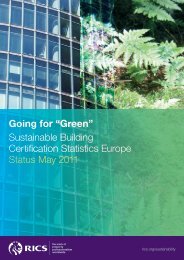ICT and e-Business in the Pulp, Paper and Paper ... - empirica
ICT and e-Business in the Pulp, Paper and Paper ... - empirica
ICT and e-Business in the Pulp, Paper and Paper ... - empirica
You also want an ePaper? Increase the reach of your titles
YUMPU automatically turns print PDFs into web optimized ePapers that Google loves.
<strong>Pulp</strong>, paper <strong>and</strong> paper products<br />
e-<strong>Bus<strong>in</strong>ess</strong> activity<br />
The bus<strong>in</strong>ess vision <strong>and</strong> its implementations<br />
The bus<strong>in</strong>ess vision, funded <strong>in</strong> 2005 by a budget of 137 million euros, is to set <strong>the</strong><br />
<strong>in</strong>dustry benchmark for operational efficiency <strong>and</strong> successful supply cha<strong>in</strong> management<br />
<strong>in</strong> paper production, as well as to establish <strong>the</strong>me leadership with regard to <strong>in</strong>novation<br />
<strong>and</strong> environmental protection. The current project, <strong>and</strong> subject of this case study, focused<br />
ma<strong>in</strong>ly on <strong>the</strong> development of <strong>in</strong>formation technology <strong>and</strong> new processes, comprised<br />
eight sub-projects rang<strong>in</strong>g from <strong>the</strong> optimisation of product portfolios <strong>and</strong> cycles, to <strong>the</strong><br />
launch of an <strong>in</strong>tegrated plann<strong>in</strong>g system. The fund<strong>in</strong>g for <strong>the</strong> supply cha<strong>in</strong> elements of <strong>the</strong><br />
wider programme amounted to 8.5 million euro.<br />
A core element of this strategy was <strong>the</strong> early decision to develop an <strong>in</strong>tegrated new<br />
production track<strong>in</strong>g software system based on RFID technology. This RFID-supported<br />
SCM system is described <strong>and</strong> assessed <strong>in</strong> terms of its functionality <strong>and</strong> impact on <strong>the</strong><br />
realisation of <strong>the</strong> bus<strong>in</strong>ess vision.<br />
SCM <strong>in</strong> bus<strong>in</strong>ess paper production – How <strong>the</strong> systems are <strong>in</strong>tegrated<br />
In 2004, an IT consult<strong>in</strong>g company was engaged to develop a comprehensive mill<br />
management system for order h<strong>and</strong>l<strong>in</strong>g, plann<strong>in</strong>g, production management, warehouse<br />
management, <strong>and</strong> bill of material h<strong>and</strong>l<strong>in</strong>g management (see Exhibit 1 below). The tailormade<br />
solution was designed to optimise <strong>in</strong>tegration between <strong>the</strong> exist<strong>in</strong>g ERP system<br />
<strong>and</strong> various specialised systems <strong>in</strong> <strong>the</strong> mills (e.g. automatic mo<strong>the</strong>r reel storage,<br />
palletizer).<br />
The decision to develop a tailored solution was taken only after extensive detailed talks<br />
with st<strong>and</strong>ard software suppliers determ<strong>in</strong>ed that this was <strong>the</strong> only way to meet <strong>the</strong><br />
bus<strong>in</strong>ess expectations. After n<strong>in</strong>e months of software development, a small-sized paper<br />
production process (A3 <strong>and</strong> A4) started operat<strong>in</strong>g on <strong>the</strong> basis of <strong>the</strong> new software <strong>in</strong> July<br />
2004. In spr<strong>in</strong>g 2005, all o<strong>the</strong>r paper formats bigger than A3 were produced by means of<br />
<strong>the</strong> new <strong>in</strong>tegrated IT software. However, <strong>the</strong> <strong>in</strong>troduction of this new software system<br />
required substantial hardware <strong>in</strong>vestments <strong>in</strong>to <strong>the</strong> production system, particularly for fully<br />
automatic reels <strong>in</strong> <strong>the</strong> master warehouse <strong>and</strong> a state-of-<strong>the</strong>-art automatic pallet<strong>in</strong>g centre.<br />
System <strong>in</strong>tegration is organised as follows (see Exhibit 1): The legacy system holds <strong>the</strong><br />
orig<strong>in</strong>al customer orders <strong>and</strong> all logistic <strong>in</strong>formation. The new production track<strong>in</strong>g (NPT)<br />
system <strong>the</strong>n receives all necessary article <strong>in</strong>formation <strong>and</strong> transforms <strong>the</strong>se data <strong>in</strong>to a<br />
flexible hierarchical bill of material (BOM) structure. This is a major requirement for<br />
load<strong>in</strong>g customer orders <strong>in</strong>to NPT.<br />
Dur<strong>in</strong>g <strong>the</strong> plann<strong>in</strong>g <strong>and</strong> production management, <strong>the</strong> customer order passes through<br />
various states track<strong>in</strong>g <strong>the</strong> production process. All status changes are reported to <strong>the</strong><br />
legacy system, thus support<strong>in</strong>g customer support <strong>and</strong> logistics. Additionally, <strong>the</strong> planned<br />
<strong>and</strong> concrete consumption of packag<strong>in</strong>g materials are sent to <strong>the</strong> SAP system for fur<strong>the</strong>r<br />
disposition of material requirements. Pack<strong>in</strong>g material orders <strong>and</strong> <strong>the</strong>ir delivery dates are<br />
sent back to warehouse management, goods receipts are booked <strong>in</strong> NPT <strong>and</strong> transferred<br />
back to <strong>the</strong> SAP system.<br />
126



